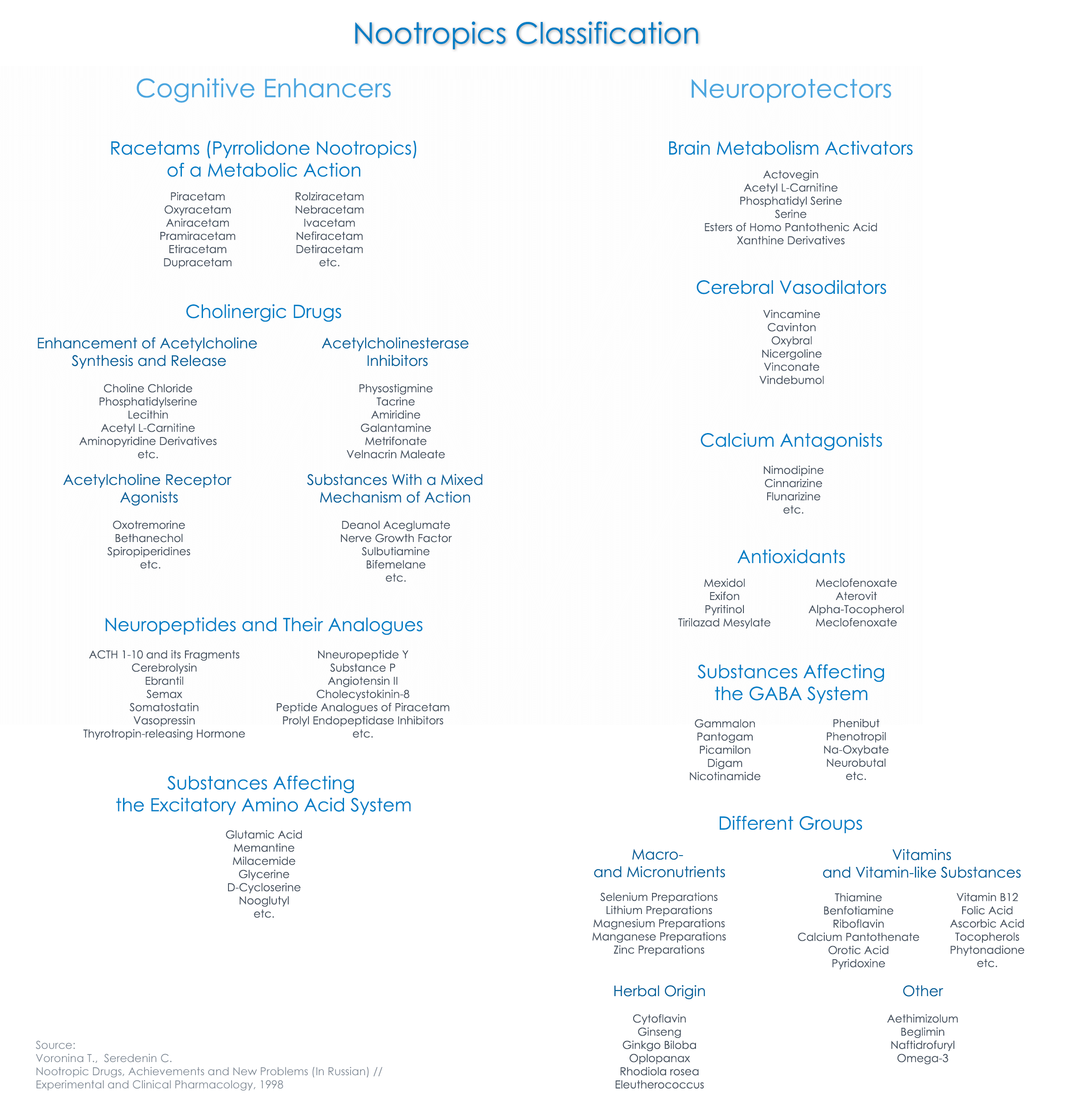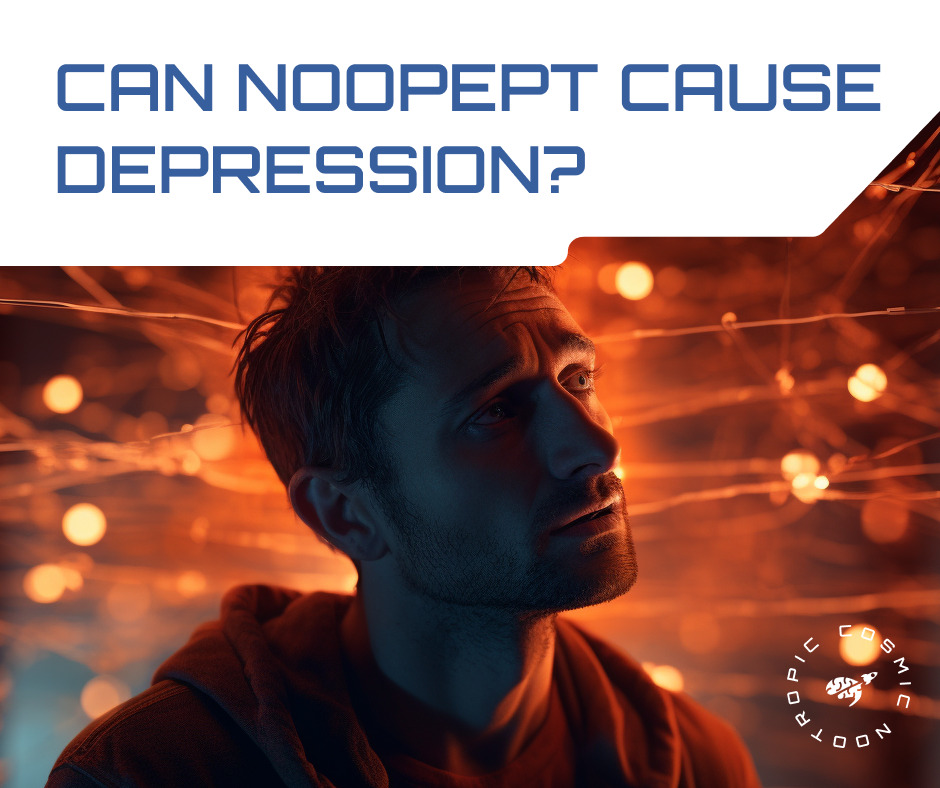USSR Classification of Nootropics
November 3, 2021
Despite quite a long history of nootropic drugs, there is still no single classification that would be ok with both pharmacologists and clinical physicians. On the one hand, this is because of the extreme diversity of the group and the difference in the action of its constituent substances, and on the other, the vagueness of the nootropic effect itself. That is why researchers have to deal with classification approaches which are not always the best to fit the purpose. In this article, several USSR-originating classifications of nootropics are suggested in order to help you structure their wide variety.
Table of Contents:
- Classification of Nootropics No.1
- Classification of Nootropics No.2
- Classification of Nootropics No.3
- Classification of Nootropics No.4
- The Author of the Classification
- Classification of Nootropics by CosmicNootropic
Classification of Nootropics No.1
One of the first and most complete Soviet classifications of nootropics proceeded from the chemical structure, as well as the mechanism of the cellular action of substances. It included 8 main groups of drugs:
- Derivatives of pyrrolidone: piracetam, etiracetam, pramistar (pramiracetam) and others.
- Derivatives of dimethylaminoethanol: dimethylaminoethanol (DMAE), meclofenoxate, euclidan, and others.
- Derivatives of pyridoxine: pyritinol, gutimine.
- Derivatives of GABA: nicotinoyl GABA (Picamilon), phenibut, pantogam, gammalon, sodium oxybutyrate, and others.
- Cerebrovascular substances: vinpocetine, nicergoline (Sermion), hydergine, and others.
- Neuropeptides and their analogs: ACTH and its fragments (Semax), vasopressin and oxytocin, thyroliberin and melanostatin, endogenous opioids, pyroglutamyl, dipeptides.
- Antioxidants: 2-ethyl-6-methyl-3-hydroxypyridine (Mexidol), ionol.
- Various substances with a component of nootropic action: aethimizolum, orotic acid, oxymetacil, xanthinol nicotinate, ginseng, and others.
Later, this classification of nootropics was modified and supplemented with an emphasis not on the chemical structure, but on the pharmacological properties of substances.
Classification of Nootropics No.2
In the updated form this classification of nootropics consists of two large groups: nootropics with a predominance of the mnestic effect (“cognitive enhancers“) and substances of a mixed type (“neuroprotectors“). Each of them is represented by several subgroups:
I. Nootropic drugs with a dominant mnestic effect
1. Pyrrolidone nootropics (racetams), mainly of metabolic action: piracetam, oxiracetam, aniracetam, pramistar (pramiracetam), rolziracetam and others.
2. Cholinergic substances:
- increased synthesis of acetylcholine and its release (choline chloride, phosphatidylserine, Lecithin, L-carnitine, aminopyridine derivatives, and others),
- cholinergic receptor agonists (oxotremorine, bethanechol, spiropyridines, dinucleotides, and others),
- acetyl cholinesterase inhibitors: physostigmine, tacrine, amiridine, galantamine, metrifonate, velnacrine, and others,
- substances with a mixed mechanism: demanol aceglumate (DMAE), nerve growth factor (NGF), sulbutiamine, and others.
3. Neuropeptides and their analogs: ACTH and its fragments (Semax), somatostatin, oxytocin and its analogs, thyroliberin and its analogs, neuropeptide Y, substance P, cholecystokinin-8 (CCK), peptide analogs of piracetam, prolyl endopeptidase inhibitors.
4. Substances with an effect on the excitatory amino acid system: glutamic acid, memantine, milacemide, glycine, nooglutyl.
II. Mixed nootropic drugs with a wide range of effects (“neuroprotective agents”)
1. Brain metabolism activators: L-carnitine, phosphatidylserine, homopantothenic acid esters, xanthine derivatives of pentoxyphylline, propentophylline, tetrahydroquinones, etc.
2. Cerebral vasodilators: vinpocetine, nicergoline, etc.
3. Calcium antagonists: nimodipine, cinnarizine, flunarizine, etc.
4. Antioxidants: Mexidol, dibunol, exiphon, pyritinol, tirilazad mesylate, meclofenoxate, atherovit (alpha-tocopherol), etc.
5. Substances affecting the GABA system: Picamilon, phenibut, pantogam, gammalon, nicotinamide, phenotropil, sodium oxybutyrate, neurobutal, etc.
6. Substances from different groups: aethimizolum, orotic acid, oxymetacil, beglimin, naftidrofuryl, cerebrocrast, ginseng, rhodiola rosea, etc.
It is clear that this classification is much more complete than the previous one and includes many new substances. Though this form has a larger pharmacological orientation, it nevertheless turns out to be quite cumbersome, partly due to the inclusion of a number of little-known and sometimes clinically insufficiently approved compounds.
Classification of Nootropics No.3
In order to simplify the task and bring the classification of nootropics closer to the needs of practical medicine, another option is recommended, which is based on the direction of the pharmacological effect. In a modified form, such a classification may include 4 main groups of drugs:
- Substances with a pronounced psycho-energizing component, effective for mental retardation in children, trauma, alcoholism, ischemia: piracetam, encephabol.
- Substances with a relatively high nootropic effect for the treatment of amnesia and effective in neurodegenerative diseases of the central nervous system (senile dementia, Alzheimer’s disease): centrophenoxine, pramistar (pramiracetam), aniracetam, choline, and Lecithin.
- Cerebroprotectors, which have a predominant effect on cerebral blood flow and which are used for disorders of cerebral circulation: vinpocetine, Picamilon, nicergoline.
- Substances of auxiliary action directly involved in the metabolism of nerve cells: orotic and nicotinic acids.
However, even this principle of dividing nootropics cannot be considered satisfactory. Here we are faced with another problem – an excessive limitation of the range of nootropic drugs and not a very successful attempt to consolidate certain clinical indications for strictly defined substances.
Classification of Nootropics No.4
Taking into account the problems outlined, another classification of nootropics was suggested by prof. Edward Arushanian (M.D.). It might not coincide with what biohackers in the West think about nootropics and cognitive enhancers but it is what neurology and pharmacology students find in their textbooks. This version is less simplified than the previous one, but at the same time, is not too cumbersome:
1) Derivatives of pyrrolidone or racetams: piracetam, oxiracetam, aniracetam, pramistar (pramiracetam) et al. It is a group with the most pronounced universal properties (stabilization of cell membranes, vasoactive, antioxidant, synaptotropic and other effects).
2) Synaptotropic drugs:
a) Cholinomimetic agents: anticholinesterase compounds (physostigmine, rivastigmine, tacrine, amiridine, donepezil) and mediator precursors (choline, citicoline).
b) GABAergic substances: aminalon, pantogam, picamilon, phenibut, sodium oxybate.
c) Glutamatergic drugs: glutamic acid, selective stimulants of the glycine site (glycine), blockers of NMDA receptors (dizocilpine, memantale).
d) Dopamine agonists: levodopa, midantan.
3) Neuroprotective agents: calcium channel blockers (nimodipine, cinnarizine), antioxidants (mexidol, meclofenoxate), membrane stabilizers (phosphatidylserine, L-carnitine), Ginkgo biloba preparations (Tanakan).
4) Cerebral vasodilators: vinpocetine, nicergoline (Sermion), pentoxyphyllinum, xantinol nicotinate.
5) Neuropeptides, hormones, and hormone-like drugs: Cerebrolysin, a stimulant for the synthesis of neurotrophins idebenone, vasopressin and its analogs, dipeptide analogs of piracetam (Noopept), ACTH4-10 drugs (Semax), thyroliberin and its derivatives, thyroid hormones (thyroxin, triiodothyronine), ovarian hormones (estrogens), pineal gland hormone melatonin.
6) Group of nootropic-like drugs that facilitate cognitive activity along with some basic specific effects. This can include many types of psychotropic compounds:
- herbal adaptogens (ginseng, leuzea, rhodiola rosea),
- psychomotor stimulants (caffeine),
- benzodiazepine anxiolytics,
- representatives of various antidepressants,
- stimulants of peripheral, in particular, retinal receptors (such as strychnine),
- platelet aggregation inhibitors,
- anti-inflammatory agents,
- vitamin complexes.
The proposed classification of nootropic drugs also has its drawbacks. In particular, it was not possible to build it entirely on a functional basis. It shall be assumed that in the future there will be new nootropic drugs, which are in dire need of modern clinical practice. Hence the classification of substances will be subject to further changes.
About the Author of the latest Classification of Nootropics
Edward Arushanian is the Doctor of Medicine, professor, and the current Head of the Pharmacology faculty of the Stavropol State Medical University (Russia) and an acting member of the New York Academy of Sciences (since 1995). Dr Arushanian was granted the Honored Scientist of Russia in 1995 as well as a number of other academic Soviet and Russian awards. His professional interest lies in neuropharmacology and neurophysiology. Dr Arushanian is the author of 855 scientific papers including 27 monographs and about 150 foreign articles, some of them can be found in PubMed. He was the mentor of 9 doctoral theses.
To read more about this prominent scientist and researcher check out the post about his book “Medical Improvement of Brain Function” ⬇️
We highly encourage and welcome you to share your comments on our post about the Russian classification of nootropics on Reddit.
Classification of Nootropics by CosmicNootropic
When choosing nootropics, people usually want to be sure: that is why we have got an idea to clearly demonstrate a nootropics classification: it could also provide a key to finding the right preparations. It is surprising, but we could not find any detailed information in English. So we made our own picture based on the classification given in a Russian scientific journal “Experimental and Clinical Pharmacology”. Click here to see the full size, and navigate better 🔎





